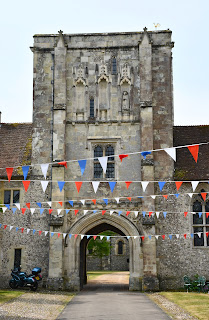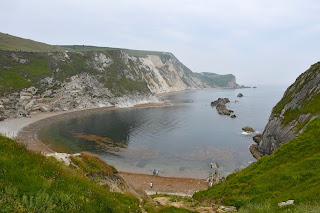Winchester and Dorset
We had borrowed our car for two days, and after returning from the Cotswolds, Johnny and I made another trip, this time to the south. Our first stop was the city of Winchester, a name that carries some emotional weight for me as I have resided at Winchester Road for the past two years. The city is sometimes described as a former capital of England, but it is now generally agreed that the royal court was mobile during England’s early Middle Ages. Associated with Alfred the Great, Winchester owes its present layout to the king’s reconstruction of the city to render it more defensible against Viking raids.
We started our visit
with a brief stop by the Hospital of Saint Cross, an almshouse constructed by
Henry of Blois in the 12th century. Still in operation, the complex
is home to two dozen elderly men, and the church appears to be well-visited by
the wider community. The latter is even popular within the animal kingdom, as
Johnny found a blackbird nest by the side-entrance of the church.
It was difficult to
find a new parking spot in the centre of the city, but we eventually arrived in
the right place at the right time (unfortunately, this was only after I had
managed to bonk the bottom of the car on a curb in a tight parking lot). We
first walked east towards the city hill, which offers a nice view of the city
skyline. Most prominent are the Guildhall and the Cathedral, with a few church
spires thrown in for good measure. We then walked south along river and around
the old Roman wall. The path beside it led us nicely to the Old Bishop’s
Palace, which is really just a pile of bricks and a few old arches. Further on,
it goes past the famous Winchester College and Kingsgate.
Since the Cathedral
had not yet opened, we decided to visit the Great Hall: the last remaining
building of Winchester Castle. The hall is impressively big given its age of
around eight hundred years. On its right is a round wooden panel which
represents King Arthur’s Round Table at Camelot. At the top sits King Arthur,
with the names of his 25 knights written around the rim. The centre of the
“table” is a Tudor Rose, as the 13th century installation was
repainted under Henry VIII. On the left of the hall are two tall forbidding
gates, constructed in commemoration of the wedding between then-Prince Charles
and Diana Spencer.
After eating lunch, we
could finally visit Winchester Cathedral. At 170 metres, it is the longest
medieval cathedral in the world but only the sixth largest cathedral in the UK.
Worth noting in the cathedral is Saint Swithun’s Shrine and the memorial to
Jane Austen, who died in Winchester in 1817.
Leaving Winchester, we
continued southwest all the way to the Dorset Coast. Our destination was West
Lulworth, which is a good starting spot for hikes along the coast. Since it was
getting quite late and the weather was not particularly good, however, we only
hiked for a short while. From the parking lot, we climbed up the Lulworth Steps
and walked to the cliff above the Man O’War Beach. We took pictures of the cove
below us before walking down the steps to the beach by Durdle Door, a prominent
arch whose base rests in the cold waters of the English Channel.
Despite the hazy weather, the place was packed. Vacationers from all around – but mostly from Eastern Europe, the Middle East, and South Asia – all somehow managed to converge in this one single spot, some turning their afternoon getaways into full-on parties. As we were interested neither in partying nor in lying on the beach, we did not spend much time there but decided to begin our drive back. The timing was fortunate. The rain started coming down as we hit the road, and it turned into a downpour throughout the evening. While this made the drive rather horrifying, I was glad that at least we did not get soaked.























































Comments
Post a Comment